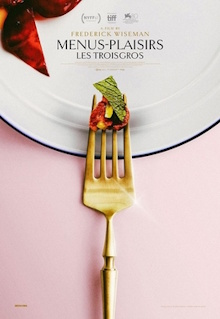Most people will never get to eat in a Michelin 3-star restaurant so watching this four hour long documentary may be the next best option. Made by Frederick Wiseman, it conforms to his usual style of not including any narration at all and covers the Troisgros family who have been chefs in the Loire département of France for generations. It focuses on their Michelin-starred Le Bois sans feuilles restaurant, offering an astonishingly complete view of their day-to-day operations. But we also get to see glimpses of their other businesses and follow along as they visit some of their suppliers, all set amidst the beautiful greenery of the region.
The film’s extensive running time allows Wiseman to explore the Troigros’ approach to cuisine at leisure. It opens with the two brothers César and Léo inspecting produce at the market in Roanne, then follows the discussion of the proposed menu with their father Michel in light of what seasonally available. We see every aspect of the operations of their restaurant as they prepare for the lunch service including cooking, the extreme level of care given to presentation, briefing the servers both on the current menu and the preferences of the guests they are expecting and much, much more. It’s impressive how much access the documentary crew is allowed as they even show how the guests experience their meals and what they have to say about it. This is understandably an edited and sanitized perspective, but it does leave in tidbits like how Michel admonishes a cook who failed to properly drain the blood from brains before storing them. The family further visit farms, a vineyard, and incredibly even a facility which cheeses are ripened. With no narration, what information we get comes from the conversations that we get to listen in on. Michel takes great delight in showing diners the kitchen and readily speaks at length about his culinary inspirations and the history of his family’s restaurants.
To say that this is highly educational would be a vast understatement. I had no idea, for example, that cheesemakers send their products to specialized facilities to have them ripened for weeks or months. It’s one thing to read about the prices of expensive wines, it’s another to be a fly on the wall as Michel discusses which wines to buy from a supplier with particular clients in mind with prices that start at 5,000 Euros. Even their servers are required to be incredibly knowledgeable in order to be able to answer questions about the composition of their dishes and the sources of the ingredients. The people they visit are naturally experts in their respective domains who provide detailed information such as how goats are raised for their milk to be made into cheese, how much produce a tomato plant is expected to yield and so on. I do think that Michel often reverts to vague generalities when speaking to them, talking about the quality of the soil and so on which is just not that interesting. There’s relatively little about the personal lives of the members of the family but we do see César’s wife and child, the matriarch Marie-Pierre who is in charge of the decor and aesthetics of their hotel, and amusingly we even see the two brothers running a food truck outside the train station of Roanne. This couldn’t have been worth their while so I must guess that it is to allow more people to try their food at a more affordable price.
Since I’m not a foodie, much of the richness of this film is lost on me but it’s always edifying to watch specialists pursue their passions and interests to the fullest. It helps too that the backdrop is the beautiful countryside of the region and you can see the cows and the goats all but frolic on the grass. One thing I especially liked is the very precise terminology the experts use and how everything they do is with the assistance of technology and underpinned by science. So while advertisements sell French luxury with romantic imagery of rustic farmers and hand tools, this film shows that what economic production at scale in the modern world is really like. The cheese ripening facility uses clean rooms at precisely calibrated temperatures. A type of cheese with a concave shape is kept that way for traditional reasons but it’s just for aesthetic reasons. One of the cheesemakers frankly states that his business is all about selling cheese made from the milk of his goats so after a month of being raised from their mother’s milk, they are fed regular milk purchased from suppliers. Like any other field, cuisine is constantly innovating and the best in the business will take every advantage they can get.
I still find it hard to believe how much access the Troigros family gave to Wiseman. Just as the film showcases the competence and dedication of the family, it also more quietly demonstrates the experience and technical ability of the director and his team in being able to capture everything including the conversations of the diners while being invisible. I do note that this merely represents the Troigros family at a specific point in time and things have already changed since it was made. Nonetheless this is an amazingly in-depth peek into the inside of one of the best restaurants in the world and hence is an invaluable documentary.
